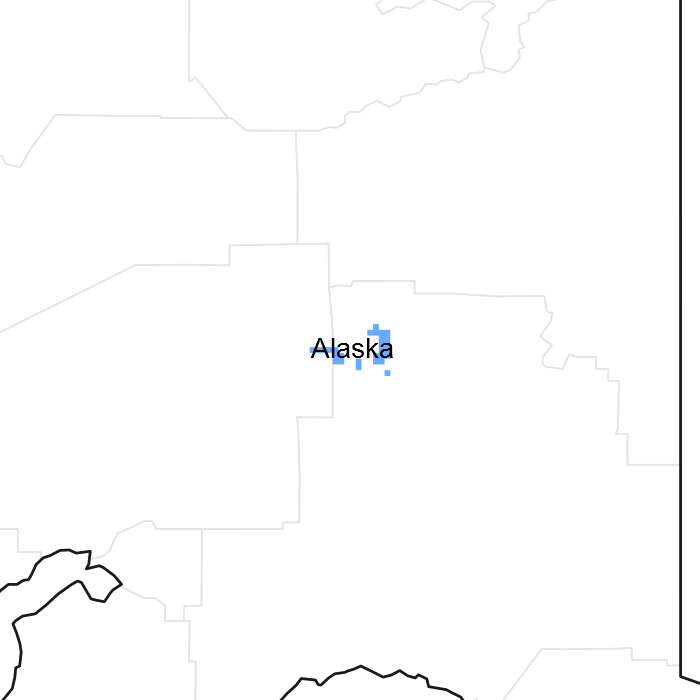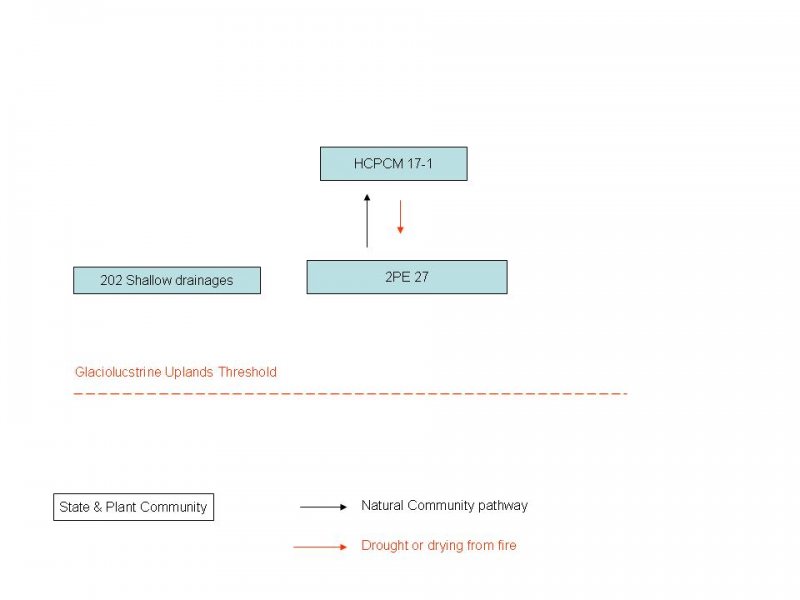
Natural Resources
Conservation Service
Ecological site R227XY202AK
Shallow Drainages Dackey cool, swedna, sankluna, ostna
Accessed: 12/20/2025
General information
Provisional. A provisional ecological site description has undergone quality control and quality assurance review. It contains a working state and transition model and enough information to identify the ecological site.

Figure 1. Mapped extent
Areas shown in blue indicate the maximum mapped extent of this ecological site. Other ecological sites likely occur within the highlighted areas. It is also possible for this ecological site to occur outside of highlighted areas if detailed soil survey has not been completed or recently updated.
Table 1. Dominant plant species
| Tree |
Not specified |
|---|---|
| Shrub |
Not specified |
| Herbaceous |
Not specified |
Physiographic features
This site consists of shallow, poorly defined drainages and upper margins of topographic depressions on glaciolacustrine uplands and occasionally on stream terraces. Slopes range from 0 to 8 percent. Elevation is generally 1850 to 2900 feet (564 to 884 m). Landscape position and soil hydrology and wetness appear to be the most important landscape features effecting this site.
This site is of minor occurrence throughout the Gulkana River area. It probably can be found on similar landscapes elsewhere in Copper River basin also.
Table 2. Representative physiographic features
| Landforms |
(1)
Flood plain
|
|---|---|
| Flooding duration | Brief (2 to 7 days) |
| Flooding frequency | Occasional |
| Elevation | 2,300 – 2,900 ft |
| Slope | 10% |
| Water table depth | 12 – 48 in |
| Aspect | Aspect is not a significant factor |
Climatic features
The subarctic continental climate of this site is characterized by long cold winters and short warm summers. Mean January temperature is -2 °F.; mean July temperature is 54 °F. Mean annual precipitation ranges from 15 to 21 inches. Annual snowfall ranges from 54 to 102 inches. The frost-free season is about 60 to 80 days (28 °F. base temperature). The growing season varies greatly from year to year and frosts can occur during any summer month.
Table 3. Representative climatic features
| Frost-free period (average) | 0 days |
|---|---|
| Freeze-free period (average) | 0 days |
| Precipitation total (average) | 0 in |
Figure 2. Monthly average minimum and maximum temperature
Influencing water features
Soil features
3.s. Soils Narrative: In most places, the soils on this site are formed in loamy lacustrine deposits and alluvium. Surface organic mat ranges from 1 to 9 inches (2 to 23 cm). Standing and slow flowing water on the surface persists most of the growing season and the soils are poorly to very poorly drained. A reduced matrix and reduction mottles are found throughout the mineral portion of the soil to 60 inches 152 cm) or more.
Table 4. Representative soil features
| Surface texture |
(1) Fine sandy loam (2) Sandy loam |
|---|---|
| Soil depth | 60 in |
| Available water capacity (0-40in) |
0.1 – 0.3 in |
Ecological dynamics
The composition of the vegetation on this site varies considerably. All stands are dominated by a low shrub layer, however, shrub composition ranges from nearly pure willow to mixed stands dominated by shrub birch. Stunted trees are common in most stands, occasionally forming a low woodland canopy. Wild fire is not likely to significantly impact this site due to persistently wet soils. Low shrub birch-willow/water sedge scrub would be expected to regenerate directly following a fire.
State and transition model

More interactive model formats are also available.
View Interactive Models
More interactive model formats are also available.
View Interactive Models
Click on state and transition labels to scroll to the respective text
State 1 submodel, plant communities
State 2 submodel, plant communities
State 1
Low Shrub Birch-willow/water sedge scrub
Community 1.1
Low Shrub Birch-willow/water sedge scrub
Low shrub birch-willow/water sedge scrub consists of open to occasionally closed stands of mixed Betula glandulosa and Salix planifolia 2 to 6 feet (0.6 to 1.8 m) in height. In many stands, either B. glandulosa or S. planifolia is rare to absent. Setting Low shrub birch-willow/water sedge scrub appears to be late seral or potential vegetation in areas with slow moving or aerated water. This type usually occurs adjacent to, or intermixed with, Sedge wet meadow and Spruce/water sedge woodland, with which it shares many vegetative characteristics and site properties. Riparian-Wetland Classification: Palustrine broad-leaved deciduous scrub-shrub, semi-permanently flooded, mineral and organic (Cowardin et al. 1979)
Forest understory. Other occasional to frequent low willows and shrubs include Potentilla fruticosa, Vaccinium uliginosum, Ledum spp., and Chamaedaphne calyculata. Scattered dwarf shrubs, including S. reticulata, S. fuscescens, Empetrum nigrum and Arctostaphylos rubra, are common in most stands. Low shrub canopy cover ranges from 40 to occasionally 90 percent. In many stands, particularly along the edges with adjacent types, Picea glauca and, to a lesser degree, P. mariana are common, often forming a stunted woodland overstory.
Below the shrub layer, Carex aquatilis and other tall, bright green Carex spp. and Calamagrostis canadensis dominate the aspect of this type. C. canadensis is usually as tall as, and intermixed with, the shrub layer while the Carex spp. are generally somewhat shorter. Eriophorum angustifolium and E. brachyantherum are common to well-represented in some stands. Except for Equisetum spp. and Potentilla palustris, other herbs are generally of relatively minor importance. Mosses are abundant in most stands and slowly flowing and standing water covers a large portion of the ground surface, particularly early in the growing season.
Figure 3. Plant community growth curve (percent production by month). AK0001, MLRA 172 Balsam poplar-whitespruce/thinleaf alder. Mixed forest shrub on floodplains..
| Jan | Feb | Mar | Apr | May | Jun | Jul | Aug | Sep | Oct | Nov | Dec |
|---|---|---|---|---|---|---|---|---|---|---|---|
| J | F | M | A | M | J | J | A | S | O | N | D |
| 0 | 0 | 0 | 0 | 15 | 30 | 45 | 10 | 0 | 0 | 0 | 0 |
State 2
Spruce/water sedge woodland
Community 2.1
Spruce/water sedge woodland
Spruce/water sedge woodland consists of woodland to occasionally open stands of Picea mariana and P. glauca 9 to 20 feet (2.7 to 6.1 m) in height. The woodland understory consists of an open to occasionally moderately closed layer of low shrubs 2 to 5 feet (0.6 to 1.5 m) in height. The successional status of Spruce/water sedge woodland is uncertain. This type occurs on margins and elevated microsites in areas with slow moving or aerated water (areas usually occupied by Low shrub birch-willow/water sedge scrub) and is likely late seral or potential vegetation. Compared with the Low shrub birch-willow/water sedge scrub, Spruce/water sedge woodland occurs on soils with generally thinner organic mats. Riparian-Wetland Classification: Palustrine broad-leaved deciduous and needle-leafed evergreen scrub-shrub, seasonally flooded, mineral (Cowardin et al. 1979)
Forest overstory. Tree canopy ranges from around 10 to 30 percent. Tree basal area is generally low. In a representative stand, total basal area was 17 feet2/acre (3.9 m2/ha).
Forest understory. Important low shrubs include Salix planifolia, Betula glandulosa, Ledum spp., and Vaccinium uliginosum. Shrub canopy cover ranges from 20 to 70 percent. Slightly below to intermixed with the shrub layer is an open to moderately closed layer of Carex aquatilis and other medium, bright green Carex spp. Other important herbs in many stands include Eriophorum angustifolium and E. brachyantherum, Equisetum spp. Petasites frigidus, and Potentilla palustris. Other herbs are generally of relatively minor importance. Mosses are abundant in most stands, and slowly flowing and standing water covers a large portion of the ground surface, particularly early in the growing season.
Table 5. Ground cover
| Tree foliar cover | 10-30% |
|---|---|
| Shrub/vine/liana foliar cover | 1-40% |
| Grass/grasslike foliar cover | 1-60% |
| Forb foliar cover | 1-41% |
| Non-vascular plants | 1-50% |
| Biological crusts | 0% |
| Litter | 1-15% |
| Surface fragments >0.25" and <=3" | 0% |
| Surface fragments >3" | 0% |
| Bedrock | 0% |
| Water | 0% |
| Bare ground | 1-20% |
Additional community tables
Interpretations
Supporting information
Contributors
Michelle Schuman
Rangeland health reference sheet
Interpreting Indicators of Rangeland Health is a qualitative assessment protocol used to determine ecosystem condition based on benchmark characteristics described in the Reference Sheet. A suite of 17 (or more) indicators are typically considered in an assessment. The ecological site(s) representative of an assessment location must be known prior to applying the protocol and must be verified based on soils and climate. Current plant community cannot be used to identify the ecological site.
| Author(s)/participant(s) | |
|---|---|
| Contact for lead author | |
| Date | |
| Approved by | |
| Approval date | |
| Composition (Indicators 10 and 12) based on | Annual Production |
Indicators
-
Number and extent of rills:
-
Presence of water flow patterns:
-
Number and height of erosional pedestals or terracettes:
-
Bare ground from Ecological Site Description or other studies (rock, litter, lichen, moss, plant canopy are not bare ground):
-
Number of gullies and erosion associated with gullies:
-
Extent of wind scoured, blowouts and/or depositional areas:
-
Amount of litter movement (describe size and distance expected to travel):
-
Soil surface (top few mm) resistance to erosion (stability values are averages - most sites will show a range of values):
-
Soil surface structure and SOM content (include type of structure and A-horizon color and thickness):
-
Effect of community phase composition (relative proportion of different functional groups) and spatial distribution on infiltration and runoff:
-
Presence and thickness of compaction layer (usually none; describe soil profile features which may be mistaken for compaction on this site):
-
Functional/Structural Groups (list in order of descending dominance by above-ground annual-production or live foliar cover using symbols: >>, >, = to indicate much greater than, greater than, and equal to):
Dominant:
Sub-dominant:
Other:
Additional:
-
Amount of plant mortality and decadence (include which functional groups are expected to show mortality or decadence):
-
Average percent litter cover (%) and depth ( in):
-
Expected annual annual-production (this is TOTAL above-ground annual-production, not just forage annual-production):
-
Potential invasive (including noxious) species (native and non-native). List species which BOTH characterize degraded states and have the potential to become a dominant or co-dominant species on the ecological site if their future establishment and growth is not actively controlled by management interventions. Species that become dominant for only one to several years (e.g., short-term response to drought or wildfire) are not invasive plants. Note that unlike other indicators, we are describing what is NOT expected in the reference state for the ecological site:
-
Perennial plant reproductive capability:
Print Options
Sections
Font
Other
The Ecosystem Dynamics Interpretive Tool is an information system framework developed by the USDA-ARS Jornada Experimental Range, USDA Natural Resources Conservation Service, and New Mexico State University.
Click on box and path labels to scroll to the respective text.